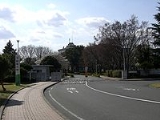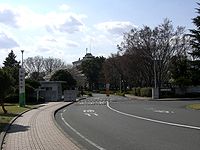
Gunma University
Encyclopedia

Japan
Japan is an island nation in East Asia. Located in the Pacific Ocean, it lies to the east of the Sea of Japan, China, North Korea, South Korea and Russia, stretching from the Sea of Okhotsk in the north to the East China Sea and Taiwan in the south...
. The main campus is located in Aramaki-machi, Maebashi City
Maebashi, Gunma
is the capital city of Gunma Prefecture, Japan.The city was founded on April 1, 1892, by the samurai Makuba Kawai.On December 5, 2004 the town of Ōgo, and the villages of Kasukawa and Miyagi, all from Seta District, were merged into Maebashi....
, Gunma Prefecture
Gunma Prefecture
is a prefecture of Japan located in the northwest corner of the Kantō region on Honshu island. Its capital is Maebashi.- History :The remains of a Paleolithic man were found at Iwajuku, Gunma Prefecture, in the early 20th century and there is a public museum there.Japan was without horses until...
.
History
Gunma University was established in 1949 by integrating the national colleges in Gunma Prefecture: , , and .Below are the histories of the predecessors of Gunma University (GU):
Maebashi College of Medical Science
Maebashi College of Medical Science was founded in 1943 as to meet the growing need of doctors during World War IIWorld War II
World War II, or the Second World War , was a global conflict lasting from 1939 to 1945, involving most of the world's nations—including all of the great powers—eventually forming two opposing military alliances: the Allies and the Axis...
. In 1948, after the war, the college was reorganized into Maebashi College of Medical Science, a four-year daigaku (age 19-23 or above). In 1949 the college was merged into Gunma University to constitute the Faculty of Medicine. The campus was located in Showa-machi, Maebashi (GU Showa Campus today).
Kiryu Technical College

Kiryu, Gunma
is a city in Gunma, Japan, near the cities of Ōta and Ashikaga. Incorporated on March 1, 1921, Kiryū is considered both a city and part of the Greater Tokyo Metropolitan Area, although it is still widely thought of as a rural area...
, whose main industry was textile manufacturing. In 1920 the college was renamed with the Department of Applied Chemistry added (Later the departments of mechanics and electronics were added). In 1944 the college was renamed in Japanese, Kiryū kōgyō semmon gakkō (桐生工業専門学校).
In 1949 the college was merged into Gunma University to constitute the Faculty of Engineering. The campus was located in Tenjin-cho, Kiryu (GU Kiryu Campus today). The former main building of the college is partly preserved as the Alumni Memorial Hall (removed to the present position in 1972 in order to build a new building with RC
Reinforced concrete
Reinforced concrete is concrete in which reinforcement bars , reinforcement grids, plates or fibers have been incorporated to strengthen the concrete in tension. It was invented by French gardener Joseph Monier in 1849 and patented in 1867. The term Ferro Concrete refers only to concrete that is...
).
Gunma Normal School
Gunma Normal School was founded in February 1873 as the Training Center For Elementary School Teachers by Gunma Prefecture government. The center was located in Maebashi. In June 1873 Gunma Prefecture was merged with a part of present-day Saitama PrefectureSaitama Prefecture
is a prefecture of Japan located in the Kantō region of the island of Honshu. The capital is the city of Saitama.This prefecture is part of the Greater Tokyo Area, and most of Saitama's cities can be described as suburbs of Tokyo, to which a large amount of residents commute each day.- History...
to constitute Kumagaya
Kumagaya, Saitama
is a city in Saitama Prefecture, Japan.As of 2010, the city has an estimated population of 203,089 . The total area is 159.88 km². The city is one of the biggest in northern Saitama Prefecture. It is the administrative, business and commercial centre in northern Saitama Prefecture. Eight...
Prefecture. The training center was renamed and removed to Honjo
Honjo, Saitama
is a city located in Saitama Prefecture, Japan.As of May 1, 2011, the city has an estimated population of 81,267, with 32,685 households and a population density of 905.89 persons per km²...
, and then to Kumagaya. In September 1876 the school was removed to Takasaki
Takasaki, Gunma
is a city located in Gunma Prefecture, Japan.The city was founded on April 1, 1900.Takasaki is a regional transportation hub because its train station is the junction of several rail lines as well as a Shinkansen stop....
and renamed , for the present-day Gunma Prefecture was established in August 1876. In October 1876 the school was removed again to Maebashi, from then on Maebashi was home to the school.
The normal school underwent several removals and renamings. In 1901 Gunma Girls' Normal School was established, and the Normal School of Gunma Prefecture became a boys' school. In 1943 the two prefectural normal schools (boys' and girls') were merged into Gunma Normal School, a national college: the men's department was located in Hiyoshi-cho, Maebashi and the women's department was in Wakamiya-cho, Maebashi. In 1949 the normal school was merged into Gunma University to constitute the Faculty of Liberal Arts (renamed Faculty of Education in 1966).
The Faculty of Education was removed to newborn Aramaki Campus in 1970, and former Hiyoshi Campus was abolished; former Wakamiya Campus is used by the GU-attached Elementary School and the School for Children with Special Needs.
Gunma Youth Normal School
Gunma Youth Normal School was founded in 1918 as Agricultural Training School (one-year school), which was attached to the Normal School of Gunma Prefecture. The purpose of the school was to nurture agricultural teachers. The school was later renamed Gunma Prefectural Training Center for Teachers of Adolescent Youth (a two-year school) in 1935. The purpose of the center was to nurture the teachers of , which were the institutions to train working youths. In 1944 the Training Center was reorganized into Gunma Youth Normal School, a national college. The school was removed to Takasaki to have an independent campus. Finally in 1947 the school got its campus in the former site of the ArmyImperial Japanese Army
-Foundation:During the Meiji Restoration, the military forces loyal to the Emperor were samurai drawn primarily from the loyalist feudal domains of Satsuma and Chōshū...
. In 1949 the normal school was merged into Gunma University to constitute the Faculty of Liberal Arts (renamed Faculty of Education in 1966). In 1951 Takasaki Campus was abolished (see Takasaki City University of Economics
Takasaki City University of Economics
is a municipal university in Japan. It is located in Takasaki City, Gunma Prefecture.- History :After World War II, the national colleges in Gunma Prefecture were merged to constitute Gunma University...
).
Faculties
- Faculty of Education (in Aramaki Campus)
- Faculty of Social and Information Studies (in Aramaki Campus)
- Faculty of Medicine (in Showa Campus)
- Faculty of Engineering (in Kiryu Campus)
Graduate Schools
- Graduate School of Education (Master's courses only)
- Graduate School of Social and Information Studies (Master's courses only)
- Graduate School of Medicine (Master's/Doctoral)
- Graduate School of Engineering (Master's/Doctoral)
Institutes
- Library and Information Technology Center
- University Hospital (in Showa Campus)
- Institute for Molecular and Cellular Regulation (in Showa Campus)
- Biosignal Genome Resource Center
- Joint Facilities for Research and Education
- Heavy Ion Medical Center (in Showa Campus)
- Advanced Technology Research Center (in Kiryu Campus)
- Innovative Center for Cooparative Research (in Kiryu Campus)
- Center for Material Research by Instrumental Analysis (in Kiryu Campus)

